sunroof BMW X1 2015 E84 Owner's Manual
[x] Cancel search | Manufacturer: BMW, Model Year: 2015, Model line: X1, Model: BMW X1 2015 E84Pages: 297, PDF Size: 7.01 MB
Page 21 of 297

All around the headliner1Emergency Request‚ÄÇ‚ÄÖ2572Panoramic glass sunroof‚ÄÇ‚ÄÖ 443Indicator lamp for the front pas‚Äê
senger airbags‚ÄÇ‚ÄÖ 924Reading lamps‚ÄÇ‚ÄÖ 895Interior lamps‚ÄÇ‚ÄÖ89Seite 19CockpitAt a glance19
Online Edition for Part no. 01 40 2 954 052 - II/15
Page 36 of 297
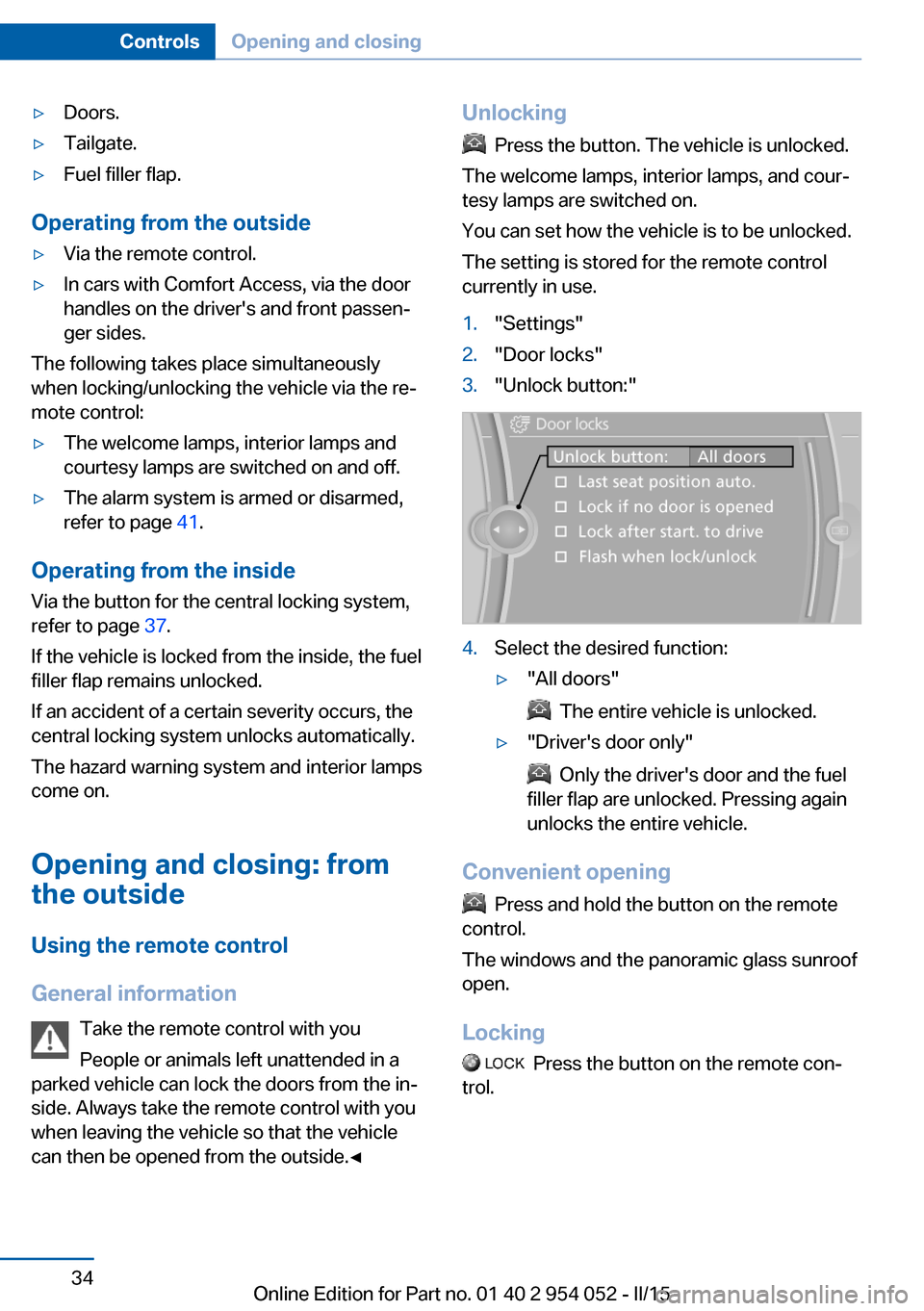
‚ñ∑Doors.‚ñ∑Tailgate.‚ñ∑Fuel filler flap.
Operating from the outside
‚ñ∑Via the remote control.‚ñ∑In cars with Comfort Access, via the door
handles on the driver's and front passen‚Äê
ger sides.
The following takes place simultaneously
when locking/unlocking the vehicle via the re‚Äê
mote control:
‚ñ∑The welcome lamps, interior lamps and
courtesy lamps are switched on and off.‚ñ∑The alarm system is armed or disarmed,
refer to page 41.
Operating from the inside
Via the button for the central locking system,
refer to page 37.
If the vehicle is locked from the inside, the fuel
filler flap remains unlocked.
If an accident of a certain severity occurs, the central locking system unlocks automatically.
The hazard warning system and interior lamps come on.
Opening and closing: from
the outside
Using the remote control
General information Take the remote control with you
People or animals left unattended in a
parked vehicle can lock the doors from the in‚Äê
side. Always take the remote control with you
when leaving the vehicle so that the vehicle
can then be opened from the outside.‚óÄ
Unlocking
Press the button. The vehicle is unlocked.
The welcome lamps, interior lamps, and cour‚Äê
tesy lamps are switched on.
You can set how the vehicle is to be unlocked.
The setting is stored for the remote control
currently in use.
1."Settings"2."Door locks"3."Unlock button:"4.Select the desired function:‚ñ∑"All doors"
The entire vehicle is unlocked.
‚ñ∑"Driver's door only"
Only the driver's door and the fuel
filler flap are unlocked. Pressing again
unlocks the entire vehicle.
Convenient opening
Press and hold the button on the remote
control.
The windows and the panoramic glass sunroof
open.
Locking
Press the button on the remote con‚Äê
trol.
Seite 34ControlsOpening and closing34
Online Edition for Part no. 01 40 2 954 052 - II/15
Page 41 of 297
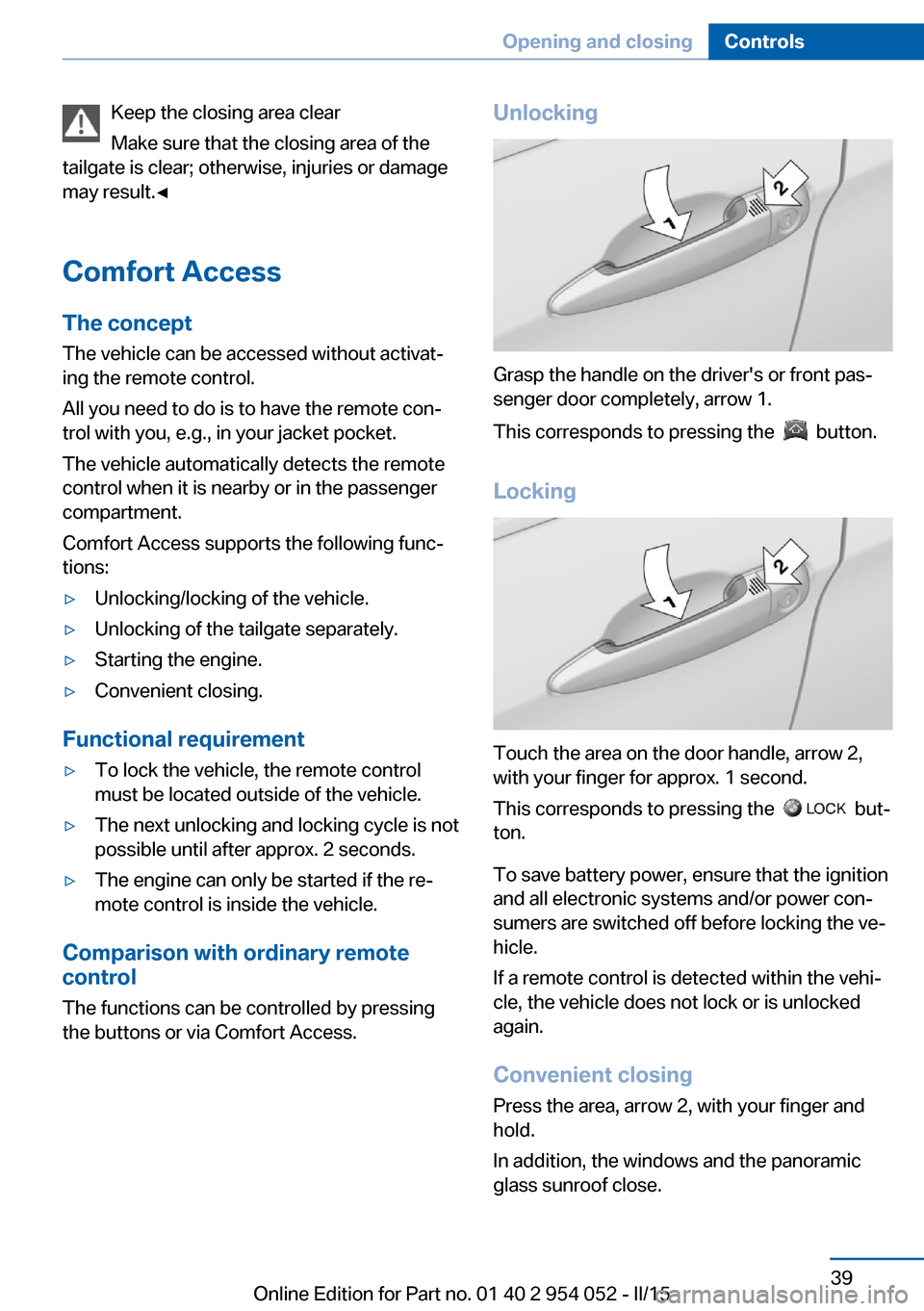
Keep the closing area clear
Make sure that the closing area of the
tailgate is clear; otherwise, injuries or damage
may result.‚óÄ
Comfort Access
The concept The vehicle can be accessed without activat‚Äê
ing the remote control.
All you need to do is to have the remote con‚Äê
trol with you, e.g., in your jacket pocket.
The vehicle automatically detects the remote
control when it is nearby or in the passenger
compartment.
Comfort Access supports the following func‚Äê
tions:‚ñ∑Unlocking/locking of the vehicle.‚ñ∑Unlocking of the tailgate separately.‚ñ∑Starting the engine.‚ñ∑Convenient closing.
Functional requirement
‚ñ∑To lock the vehicle, the remote control
must be located outside of the vehicle.‚ñ∑The next unlocking and locking cycle is not
possible until after approx. 2 seconds.‚ñ∑The engine can only be started if the re‚Äê
mote control is inside the vehicle.
Comparison with ordinary remote
control
The functions can be controlled by pressing the buttons or via Comfort Access.
Unlocking
Grasp the handle on the driver's or front pas‚Äê
senger door completely, arrow 1.
This corresponds to pressing the
button.
Locking
Touch the area on the door handle, arrow 2,
with your finger for approx. 1 second.
This corresponds to pressing the
but‚Äê
ton.
To save battery power, ensure that the ignition
and all electronic systems and/or power con‚Äê
sumers are switched off before locking the ve‚Äê
hicle.
If a remote control is detected within the vehi‚Äê
cle, the vehicle does not lock or is unlocked
again.
Convenient closing Press the area, arrow 2, with your finger and
hold.
In addition, the windows and the panoramic
glass sunroof close.
Seite 39Opening and closingControls39
Online Edition for Part no. 01 40 2 954 052 - II/15
Page 44 of 297
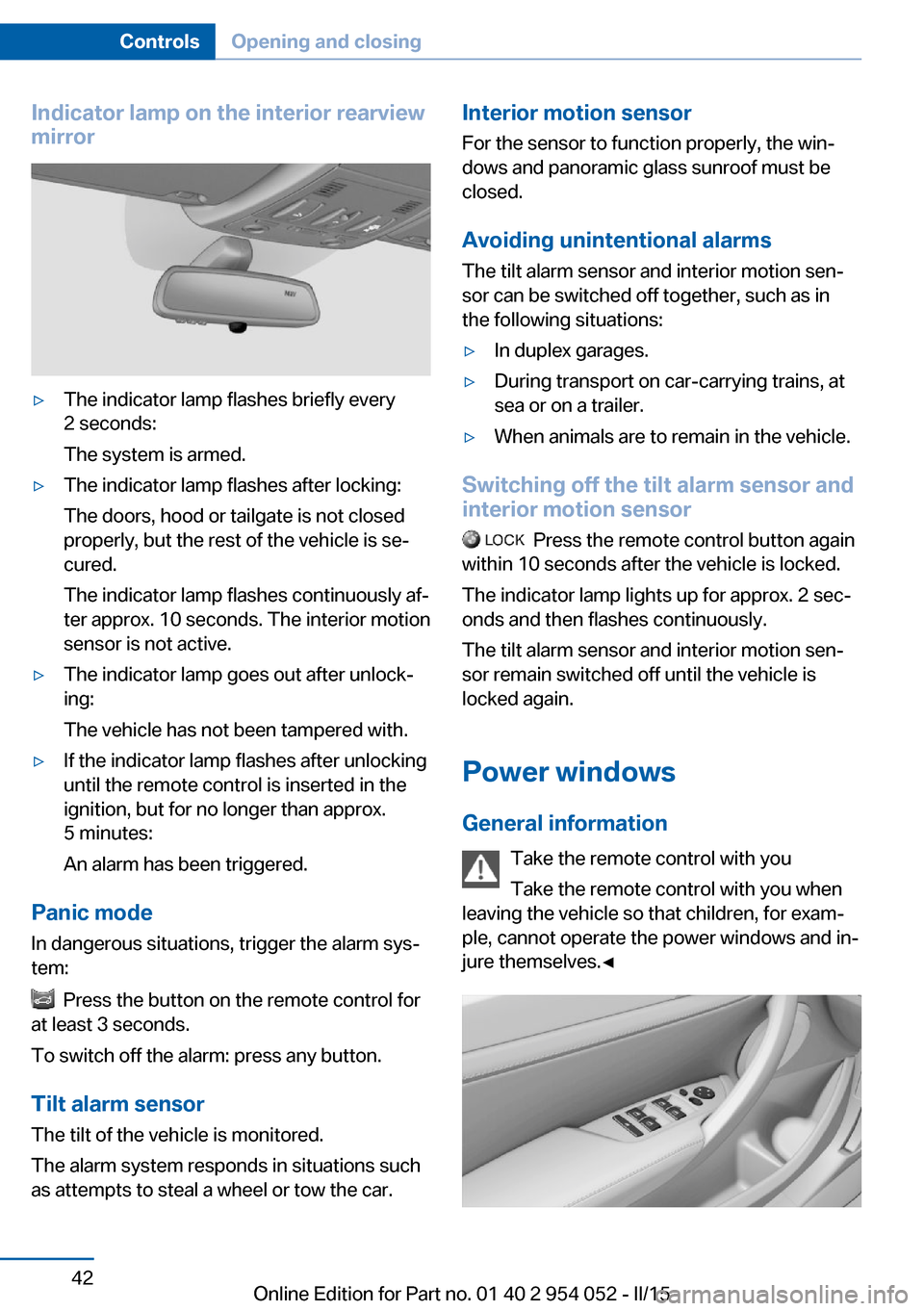
Indicator lamp on the interior rearview
mirror‚ñ∑The indicator lamp flashes briefly every
2 seconds:
The system is armed.‚ñ∑The indicator lamp flashes after locking:
The doors, hood or tailgate is not closed
properly, but the rest of the vehicle is se‚Äê
cured.
The indicator lamp flashes continuously af‚Äê
ter approx. 10 seconds. The interior motion
sensor is not active.‚ñ∑The indicator lamp goes out after unlock‚Äê
ing:
The vehicle has not been tampered with.‚ñ∑If the indicator lamp flashes after unlocking
until the remote control is inserted in the
ignition, but for no longer than approx.
5 minutes:
An alarm has been triggered.
Panic mode
In dangerous situations, trigger the alarm sys‚Äê
tem:
Press the button on the remote control for
at least 3 seconds.
To switch off the alarm: press any button.
Tilt alarm sensor The tilt of the vehicle is monitored.
The alarm system responds in situations such
as attempts to steal a wheel or tow the car.
Interior motion sensor
For the sensor to function properly, the win‚Äê
dows and panoramic glass sunroof must be
closed.
Avoiding unintentional alarms
The tilt alarm sensor and interior motion sen‚Äê
sor can be switched off together, such as in
the following situations:‚ñ∑In duplex garages.‚ñ∑During transport on car-carrying trains, at
sea or on a trailer.‚ñ∑When animals are to remain in the vehicle.
Switching off the tilt alarm sensor and
interior motion sensor
Press the remote control button again
within 10 seconds after the vehicle is locked.
The indicator lamp lights up for approx. 2 sec‚Äê
onds and then flashes continuously.
The tilt alarm sensor and interior motion sen‚Äê
sor remain switched off until the vehicle is
locked again.
Power windows General information Take the remote control with youTake the remote control with you when
leaving the vehicle so that children, for exam‚Äê
ple, cannot operate the power windows and in‚Äê
jure themselves.‚óÄ
Seite 42ControlsOpening and closing42
Online Edition for Part no. 01 40 2 954 052 - II/15
Page 46 of 297
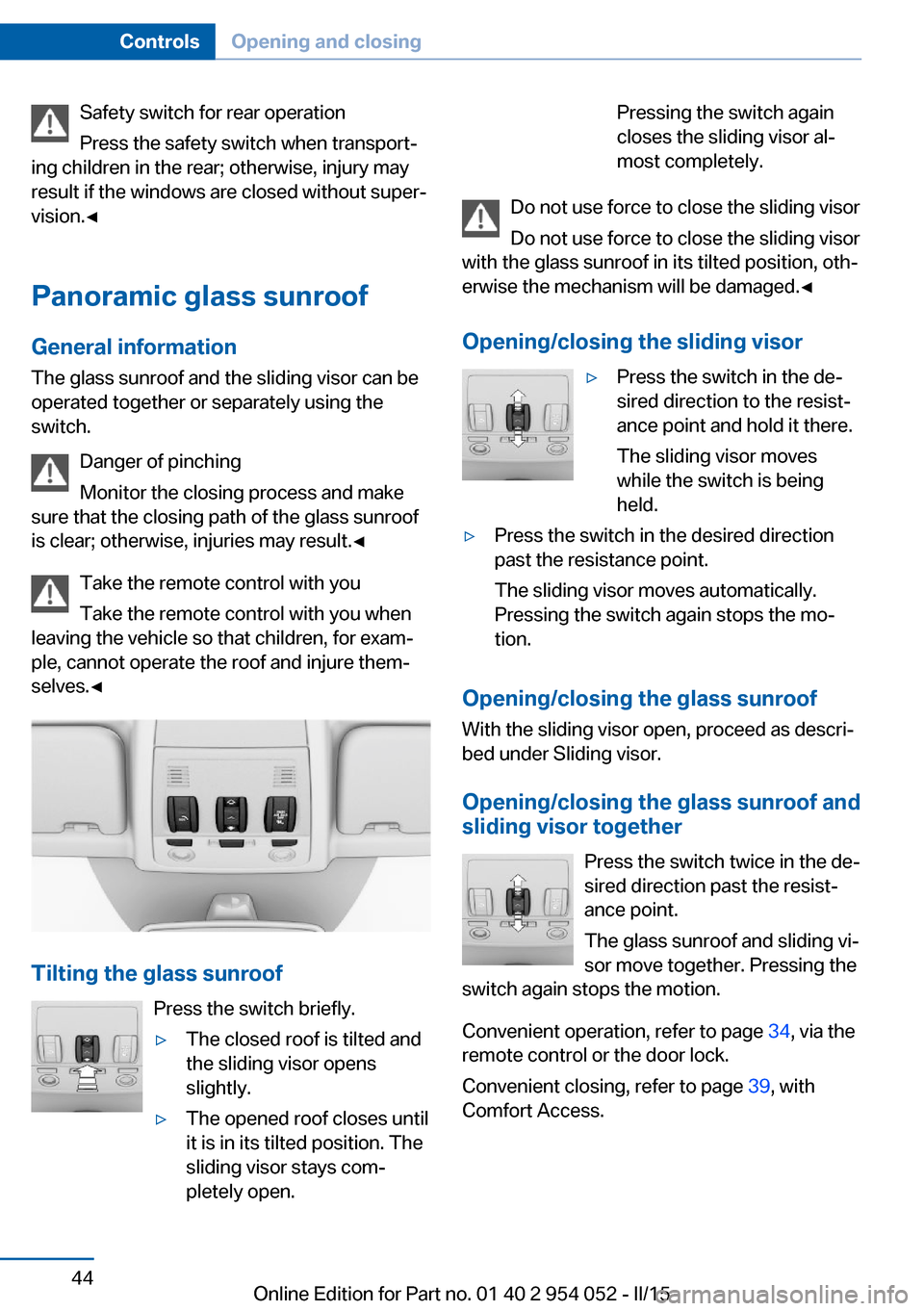
Safety switch for rear operation
Press the safety switch when transport‚Äê
ing children in the rear; otherwise, injury may
result if the windows are closed without super‚Äê
vision.‚óÄ
Panoramic glass sunroof
General information The glass sunroof and the sliding visor can be
operated together or separately using the
switch.
Danger of pinching
Monitor the closing process and make
sure that the closing path of the glass sunroof
is clear; otherwise, injuries may result.‚óÄ
Take the remote control with you
Take the remote control with you when
leaving the vehicle so that children, for exam‚Äê
ple, cannot operate the roof and injure them‚Äê
selves.‚óÄ
Tilting the glass sunroof
Press the switch briefly.
‚ñ∑The closed roof is tilted and
the sliding visor opens
slightly.‚ñ∑The opened roof closes until
it is in its tilted position. The
sliding visor stays com‚Äê
pletely open.Pressing the switch again
closes the sliding visor al‚Äê
most completely.
Do not use force to close the sliding visor
Do not use force to close the sliding visor
with the glass sunroof in its tilted position, oth‚Äê
erwise the mechanism will be damaged.‚óÄ
Opening/closing the sliding visor
‚ñ∑Press the switch in the de‚Äê
sired direction to the resist‚Äê
ance point and hold it there.
The sliding visor moves
while the switch is being
held.‚ñ∑Press the switch in the desired direction
past the resistance point.
The sliding visor moves automatically.
Pressing the switch again stops the mo‚Äê
tion.
Opening/closing the glass sunroof
With the sliding visor open, proceed as descri‚Äê
bed under Sliding visor.
Opening/closing the glass sunroof and
sliding visor together
Press the switch twice in the de‚Äê
sired direction past the resist‚Äê
ance point.
The glass sunroof and sliding vi‚Äê
sor move together. Pressing the
switch again stops the motion.
Convenient operation, refer to page 34, via the
remote control or the door lock.
Convenient closing, refer to page 39, with
Comfort Access.
Seite 44ControlsOpening and closing44
Online Edition for Part no. 01 40 2 954 052 - II/15
Page 47 of 297
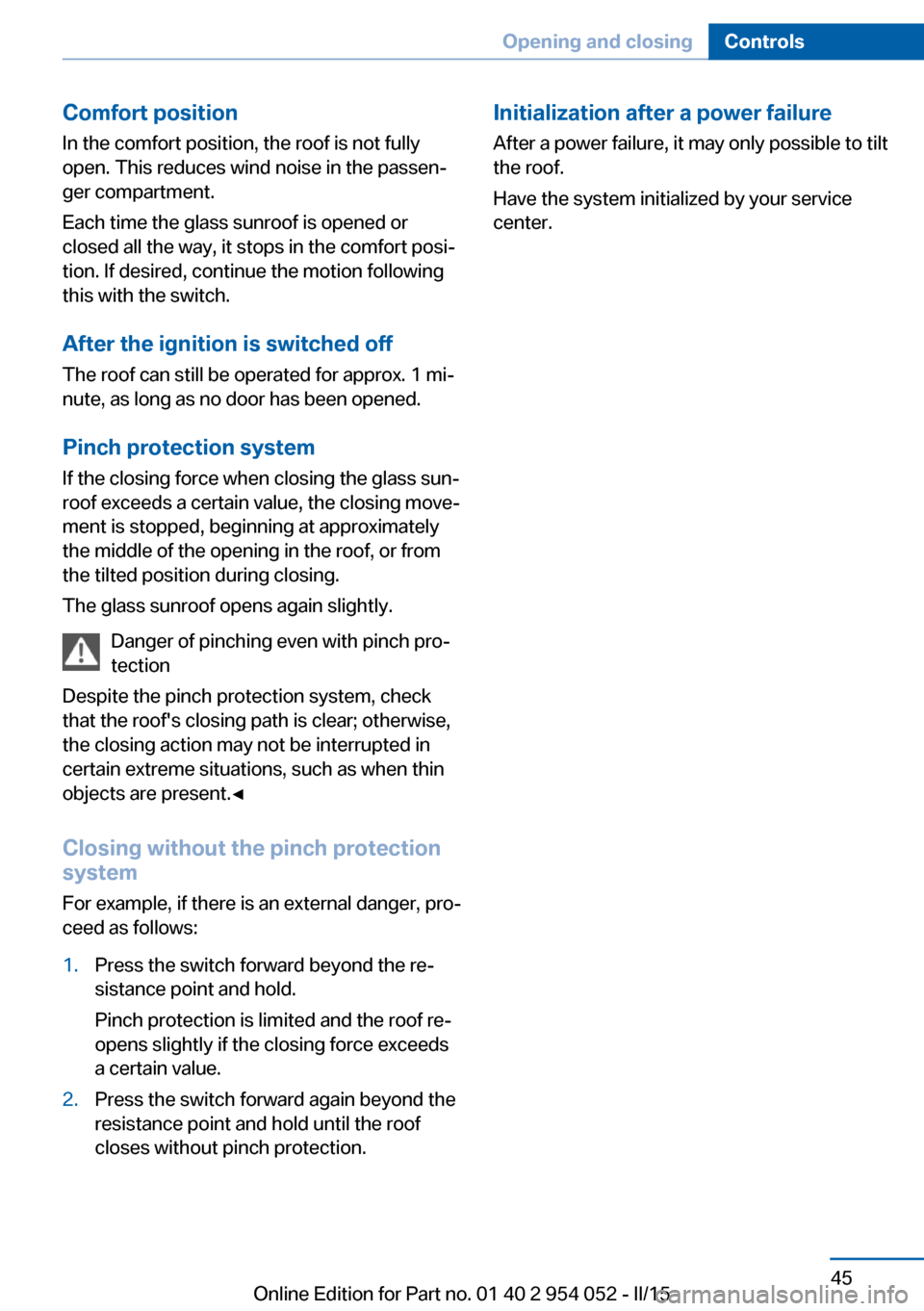
Comfort position
In the comfort position, the roof is not fully
open. This reduces wind noise in the passen‚Äê
ger compartment.
Each time the glass sunroof is opened or
closed all the way, it stops in the comfort posi‚Äê
tion. If desired, continue the motion following
this with the switch.
After the ignition is switched off
The roof can still be operated for approx. 1 mi‚Äê
nute, as long as no door has been opened.
Pinch protection system
If the closing force when closing the glass sun‚Äê
roof exceeds a certain value, the closing move‚Äê
ment is stopped, beginning at approximately
the middle of the opening in the roof, or from
the tilted position during closing.
The glass sunroof opens again slightly.
Danger of pinching even with pinch pro‚Äê
tection
Despite the pinch protection system, check
that the roof's closing path is clear; otherwise,
the closing action may not be interrupted in
certain extreme situations, such as when thin
objects are present.‚óÄ
Closing without the pinch protection
system
For example, if there is an external danger, pro‚Äê
ceed as follows:1.Press the switch forward beyond the re‚Äê
sistance point and hold.
Pinch protection is limited and the roof re‚Äê
opens slightly if the closing force exceeds
a certain value.2.Press the switch forward again beyond the
resistance point and hold until the roof
closes without pinch protection.Initialization after a power failure
After a power failure, it may only possible to tilt
the roof.
Have the system initialized by your service
center.Seite 45Opening and closingControls45
Online Edition for Part no. 01 40 2 954 052 - II/15
Page 134 of 297
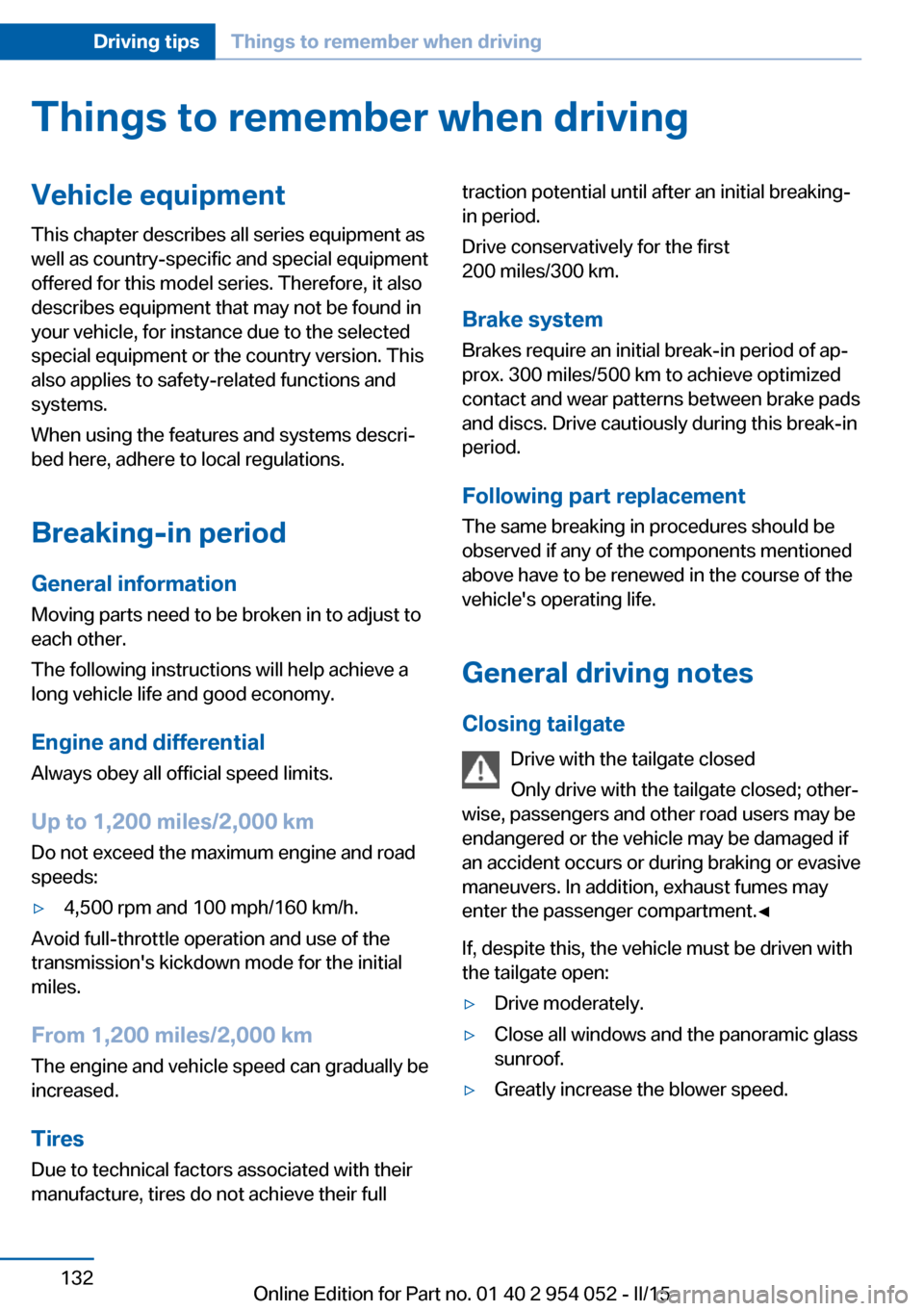
Things to remember when drivingVehicle equipment
This chapter describes all series equipment as
well as country-specific and special equipment
offered for this model series. Therefore, it also
describes equipment that may not be found in
your vehicle, for instance due to the selected
special equipment or the country version. This
also applies to safety-related functions and
systems.
When using the features and systems descri‚Äê
bed here, adhere to local regulations.
Breaking-in period General information Moving parts need to be broken in to adjust to
each other.
The following instructions will help achieve a
long vehicle life and good economy.
Engine and differential
Always obey all official speed limits.
Up to 1,200 miles/2,000 km
Do not exceed the maximum engine and road
speeds:‚ñ∑4,500 rpm and 100 mph/160 km/h.
Avoid full-throttle operation and use of the
transmission's kickdown mode for the initial
miles.
From 1,200 miles/2,000 km The engine and vehicle speed can gradually be
increased.
Tires
Due to technical factors associated with their
manufacture, tires do not achieve their full
traction potential until after an initial breaking-
in period.
Drive conservatively for the first
200 miles/300 km.
Brake system
Brakes require an initial break-in period of ap‚Äê
prox. 300 miles/500 km to achieve optimized
contact and wear patterns between brake pads and discs. Drive cautiously during this break-in
period.
Following part replacement
The same breaking in procedures should be
observed if any of the components mentioned
above have to be renewed in the course of the
vehicle's operating life.
General driving notes
Closing tailgate Drive with the tailgate closed
Only drive with the tailgate closed; other‚Äê
wise, passengers and other road users may be endangered or the vehicle may be damaged if
an accident occurs or during braking or evasive
maneuvers. In addition, exhaust fumes may enter the passenger compartment.‚óÄ
If, despite this, the vehicle must be driven with
the tailgate open:‚ñ∑Drive moderately.‚ñ∑Close all windows and the panoramic glass
sunroof.‚ñ∑Greatly increase the blower speed.Seite 132Driving tipsThings to remember when driving132
Online Edition for Part no. 01 40 2 954 052 - II/15
Page 140 of 297
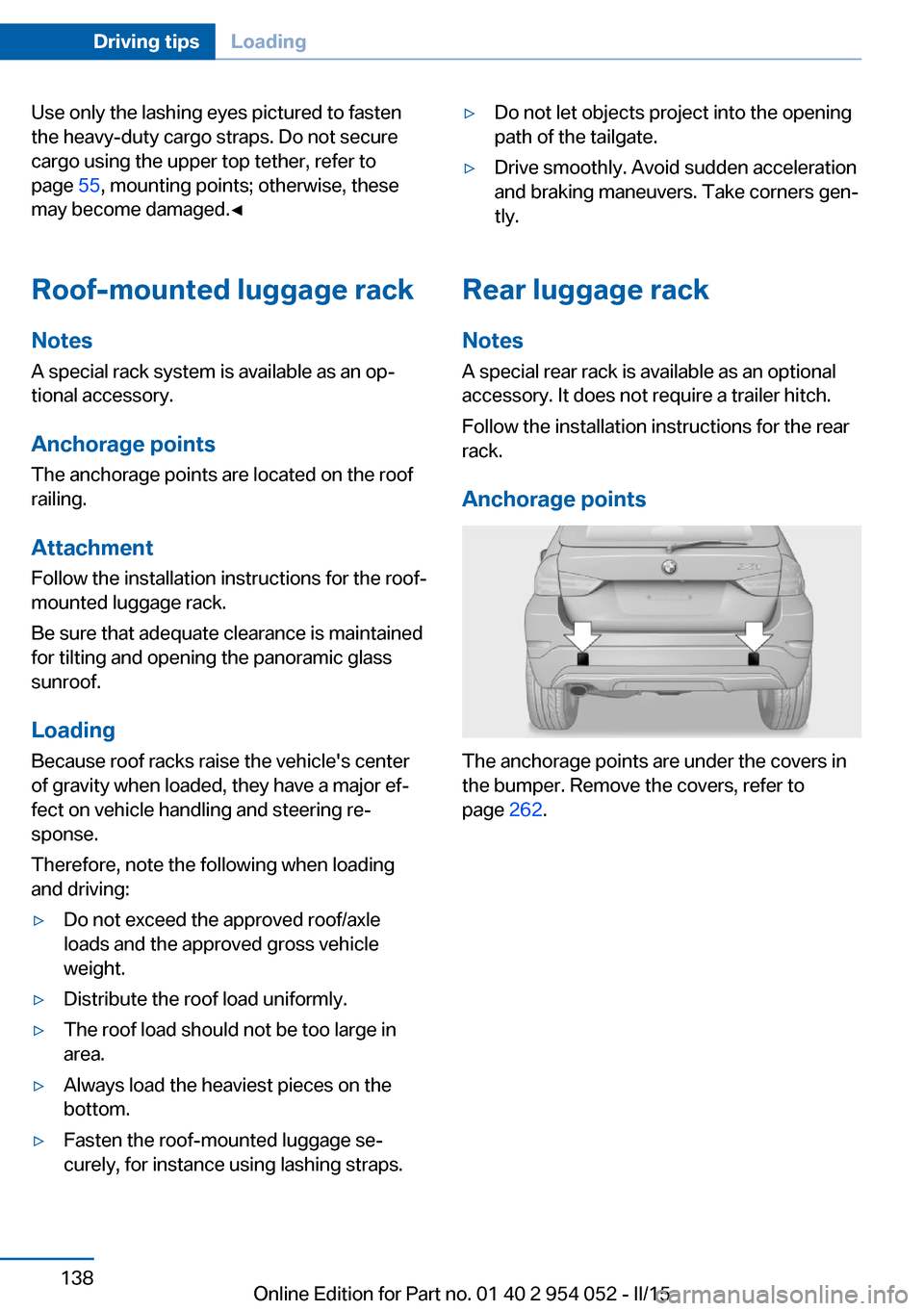
Use only the lashing eyes pictured to fasten
the heavy-duty cargo straps. Do not secure
cargo using the upper top tether, refer to
page 55, mounting points; otherwise, these
may become damaged.‚óÄ
Roof-mounted luggage rack
Notes A special rack system is available as an op‚Äê
tional accessory.
Anchorage points The anchorage points are located on the roof
railing.
Attachment Follow the installation instructions for the roof-
mounted luggage rack.
Be sure that adequate clearance is maintained
for tilting and opening the panoramic glass
sunroof.
Loading Because roof racks raise the vehicle's center
of gravity when loaded, they have a major ef‚Äê
fect on vehicle handling and steering re‚Äê
sponse.
Therefore, note the following when loading
and driving:‚ñ∑Do not exceed the approved roof/axle
loads and the approved gross vehicle
weight.‚ñ∑Distribute the roof load uniformly.‚ñ∑The roof load should not be too large in
area.‚ñ∑Always load the heaviest pieces on the
bottom.‚ñ∑Fasten the roof-mounted luggage se‚Äê
curely, for instance using lashing straps.‚ñ∑Do not let objects project into the opening
path of the tailgate.‚ñ∑Drive smoothly. Avoid sudden acceleration
and braking maneuvers. Take corners gen‚Äê
tly.
Rear luggage rack
Notes A special rear rack is available as an optional
accessory. It does not require a trailer hitch.
Follow the installation instructions for the rear
rack.
Anchorage points
The anchorage points are under the covers in
the bumper. Remove the covers, refer to
page 262.
Seite 138Driving tipsLoading138
Online Edition for Part no. 01 40 2 954 052 - II/15
Page 141 of 297

Saving fuelVehicle equipmentThis chapter describes all series equipment as
well as country-specific and special equipment
offered for this model series. Therefore, it also
describes equipment that may not be found in
your vehicle, for instance due to the selected
special equipment or the country version. This
also applies to safety-related functions and
systems.
When using the features and systems descri‚Äê
bed here, adhere to local regulations.
General information Your vehicle contains advanced technology for
the reduction of fuel consumption and emis‚Äê
sions.
Fuel consumption depends on a number of dif‚Äê
ferent factors.
The implementation of certain measures, driv‚Äê
ing style and regular maintenance, refer to
page 247, can have an influence on fuel con‚Äê
sumption and on the environmental impact.
Remove unnecessary cargo
Additional weight increases fuel consumption.
Remove attached parts
following use
Remove unneeded auxiliary mirrors, roof or
rear luggage racks after use.
Attached parts on the vehicle impair the aero‚Äê
dynamics and increase the fuel consumption.Closing the windows and
panoramic glass sunroof
Driving with the panoramic glass sunroof and
windows open results in increased air resist‚Äê
ance and raises fuel consumption.
Check the tire inflationpressure regularly
Check and, if necessary, correct the tire infla‚Äê
tion pressure, refer to page 232, at least twice
a month and before starting on a long trip.
Low tire inflation pressure increases rolling re‚Äê
sistance and thus raises fuel consumption and
tire wear.
Drive away without delay
Do not wait for the engine to warm-up while
the vehicle remains stationary. Start driving
right away, but at moderate engine speeds.
This is the fastest way for the cold engine to
reach its operating temperature.
Look well ahead when
driving
Avoid unnecessary acceleration and braking.
By maintaining a suitable distance to the vehi‚Äê
cle driving ahead of you.
Driving smoothly and looking ahead reduces
fuel consumption.
Avoid high engine speeds
Driving at a low engine speed reduces fuel
consumption and minimizes wear.Seite 139Saving fuelDriving tips139
Online Edition for Part no. 01 40 2 954 052 - II/15
Page 258 of 297
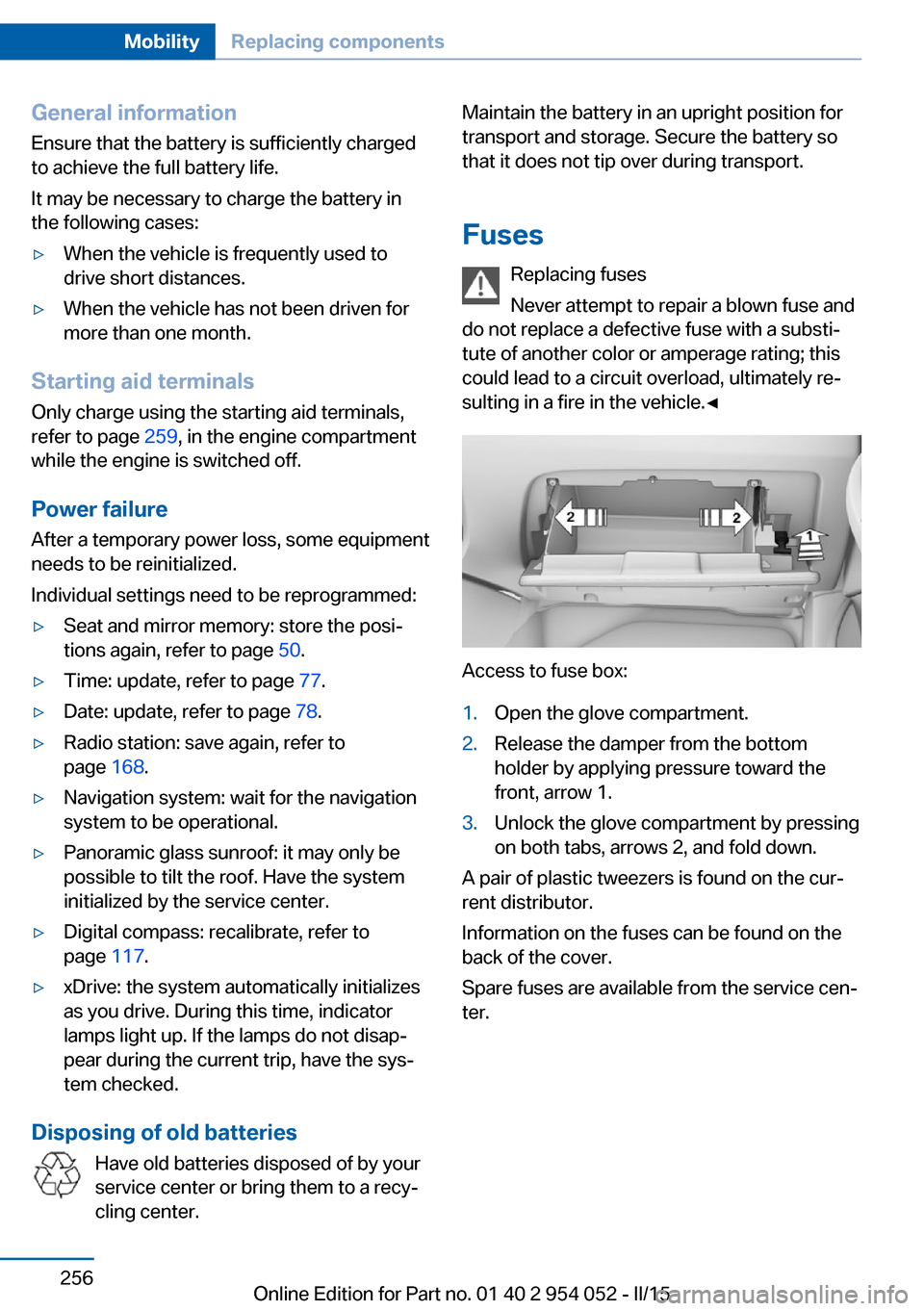
General information
Ensure that the battery is sufficiently charged
to achieve the full battery life.
It may be necessary to charge the battery in
the following cases:‚ñ∑When the vehicle is frequently used to
drive short distances.‚ñ∑When the vehicle has not been driven for
more than one month.
Starting aid terminals
Only charge using the starting aid terminals,
refer to page 259, in the engine compartment
while the engine is switched off.
Power failure
After a temporary power loss, some equipment
needs to be reinitialized.
Individual settings need to be reprogrammed:
‚ñ∑Seat and mirror memory: store the posi‚Äê
tions again, refer to page 50.‚ñ∑Time: update, refer to page 77.‚ñ∑Date: update, refer to page 78.‚ñ∑Radio station: save again, refer to
page 168.‚ñ∑Navigation system: wait for the navigation
system to be operational.‚ñ∑Panoramic glass sunroof: it may only be
possible to tilt the roof. Have the system
initialized by the service center.‚ñ∑Digital compass: recalibrate, refer to
page 117.‚ñ∑xDrive: the system automatically initializes
as you drive. During this time, indicator
lamps light up. If the lamps do not disap‚Äê
pear during the current trip, have the sys‚Äê
tem checked.
Disposing of old batteries
Have old batteries disposed of by your
service center or bring them to a recy‚Äê
cling center.
Maintain the battery in an upright position for
transport and storage. Secure the battery so
that it does not tip over during transport.
Fuses Replacing fuses
Never attempt to repair a blown fuse and
do not replace a defective fuse with a substi‚Äê
tute of another color or amperage rating; this
could lead to a circuit overload, ultimately re‚Äê
sulting in a fire in the vehicle.‚óÄ
Access to fuse box:
1.Open the glove compartment.2.Release the damper from the bottom
holder by applying pressure toward the
front, arrow 1.3.Unlock the glove compartment by pressing
on both tabs, arrows 2, and fold down.
A pair of plastic tweezers is found on the cur‚Äê
rent distributor.
Information on the fuses can be found on the
back of the cover.
Spare fuses are available from the service cen‚Äê
ter.
Seite 256MobilityReplacing components256
Online Edition for Part no. 01 40 2 954 052 - II/15